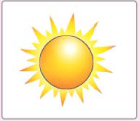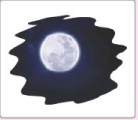Sky Above Us Class 1 Notes Science
| Table of contents |

|
| The sky |

|
| The Sun |

|
| The Moon |

|
| The Stars |

|
| Try it out |

|
| Let Us Revise |

|
The sky
We see the sun, moon and stars in the sky. These are together called heavenly bodies. The sun is a star too and our earth is a planet while the moon is a natural satellite. All heavenly bodies in space are called the universe.
Colour the objects that you can see in the sky during the day in yellow. Colour the ones that you can see in the night in blue.
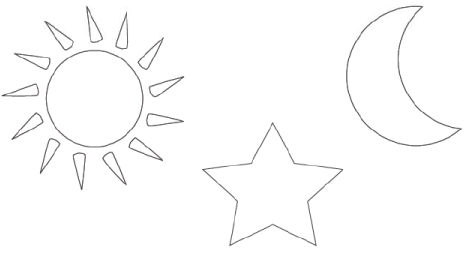
If we stand in an open place and look up, we see the sky. We see many different things in the sky at different times. During the day, we can see the sun. The sky looks bright.
We may also see clouds, birds, aeroplanes and helicopters in the sky.
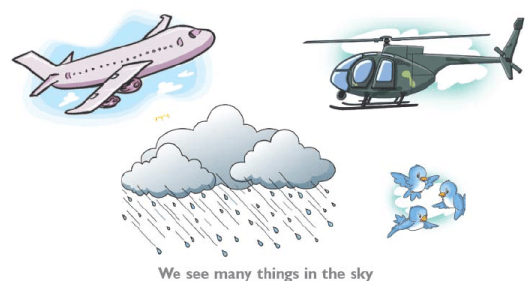
In the night, the sky looks dark. We can see the moon and the stars.
The Sun
The sun is a big ball of fire. It is a star. It gives us light and warmth.
Every morning, the sun rises in the East. The rising of the sun is called sunrise. As the sun rises, it spreads light and the day begins.
Every evening, the sun sets in the West. The setting of the sun is called sunset.
As the sun sets, it becomes dark and night falls.
The sun is very big but as it is very far away from the earth, it looks small.

Do you know?
We see that the position of the sun changes in the sky with time. But this is because the earth is moving around the sun and not the other way around.
The Moon
After sunset, we see the moon in the sky.
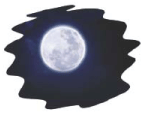
The moon gives us light at night. But this light is not of its own. It is the light of the sun which falls on the moon.
In size, the moon is much smaller than the sun. Yet, it appears big because it is much closer to the earth. In fact, it is smaller than the earth also.
The shape of the moon changes every night.
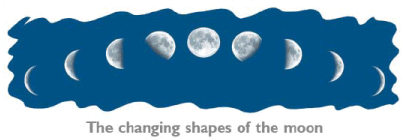
The Stars
We also see many stars twinkling in the night sky. Like the sun, they are also very hot. But, as they are far away from the earth, their warmth does not reach us. And due to their being far away, they also appear like tiny spots in the sky.

Do you know?
The first man to step on the moon was Neil Alden Armstrong.
Do you know?
In earlier times, sailors used to find their direction in the sea with the help of the stars. When the sailors saw the North Star in front of them in the sky, they knew they were moving in the North direction.
Try it out
Which of the following is not seen in the sky at night?
Let Us Revise
- The sky looks bright during the day and dark in the night.
- The sun is a big ball of fire.
- The sun gives us light and warmth.
- The sun rises in the East and sets in the West.
- It becomes day with sunrise and dark with sunset.
- The moon gives us light at night.
- The tiny, twinkling stars in the night sky are actually very hot, just like the sun.
|
33 videos|215 docs|44 tests
|
FAQs on Sky Above Us Class 1 Notes Science
| 1. What is the significance of the sky? |  |
| 2. How does the Sun affect the Earth's atmosphere? |  |
| 3. Why does the Moon appear to change its shape? |  |
| 4. How are stars formed? |  |
| 5. Can we see all the stars in the sky? |  |



